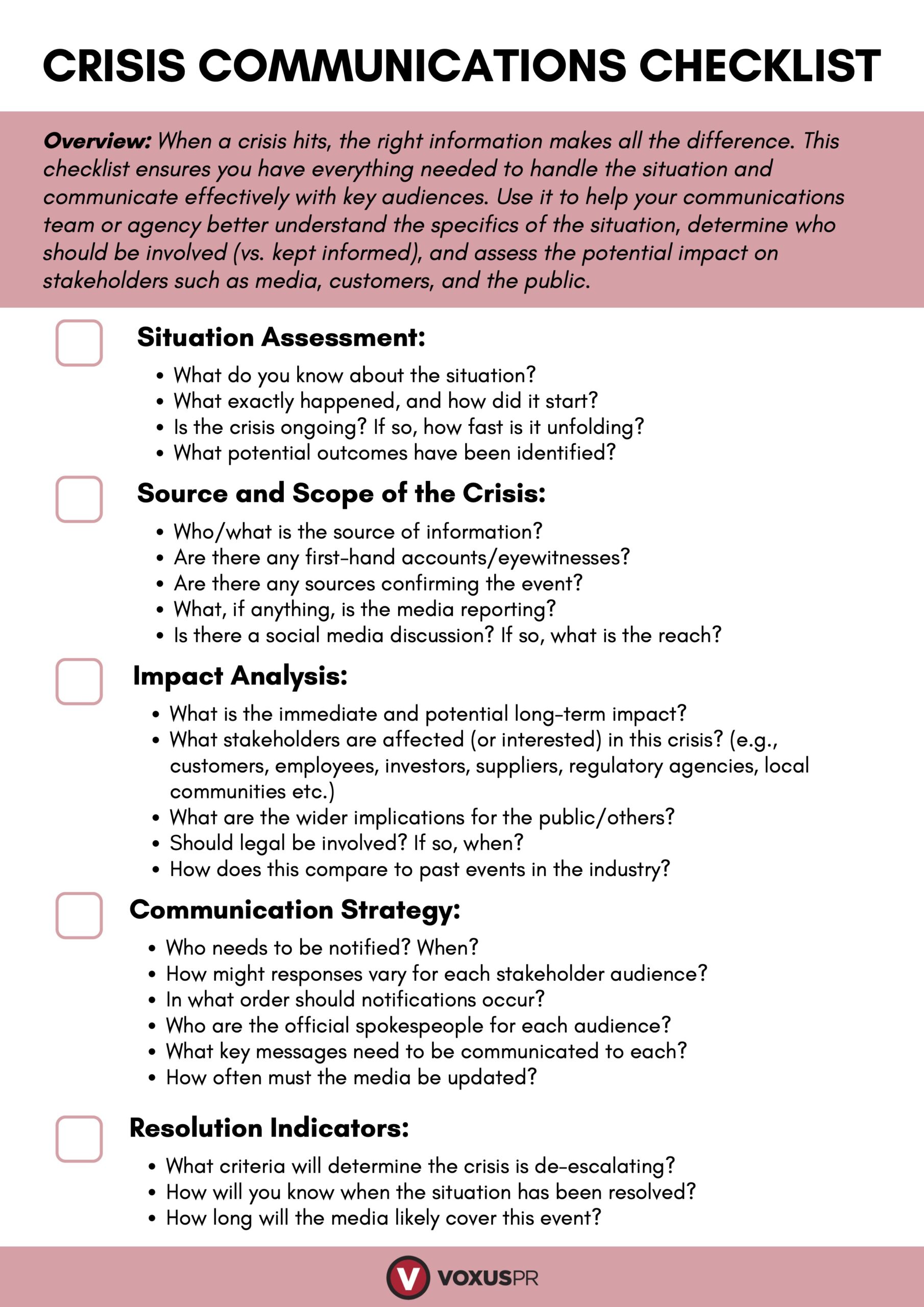Communicators today face potential crises around every corner. The headlines are endless: Roku, Columbia University, Kellogg’s, Apple, the Royal Family. And that’s just the past few weeks. While these examples involve renowned international brands with large corporate communications teams, I have found that many B2B technology brands – especially rapidly growing startups – are wholly unprepared to respond to a crisis.
How companies manage issues that could impact customer sentiment, or their brand reputation has changed in recent years. This is largely due to our accelerating news cycle and the ability for information to spread rapidly on social media. At the same time, employees, users/customers, regulators, news media, and other stakeholders rightfully expect greater accountability from the organizations they associate with.
If you’re a PR pro, this probably keeps you up at night. In her “Wear Sunscreen” commencement essay (popularized for the class of ’99 by Baz Luhrmann), Chicago Tribune columnist Mary Schmich wasn’t thinking about communicators when she wrote, “The real troubles in your life are apt to be things that never crossed your worried mind, the kind that blindside you at 4 p.m. on some idle Tuesday,” but we can certainly all relate.

Whether you’re responsible for writing or simply updating your company’s crisis communications plan, you want peace of mind in knowing you’re ready if (when) an event strikes. Consider the following tips to help respond responsibly and protect your brand’s reputation in the event of a communications crisis.
1. Communications Risk Assessment
The first step in any communications crisis is to understand and assess the severity of the situation. This is to prevent both over-response to situations that merely bear monitoring (and avoid shining a spotlight on a relatively minor issue) and to ensure there isn’t a lack of adequate attention and response to moderate or severe issues.
B2B tech companies, for example, may wish to focus on potential situations such as product outages, controversial customers or programs, fraud, or data breaches. A color-coded categorization system can help distinguish between minor (events to be monitored, issues requiring no or limited response) and major (active response needed, full-scale crisis response required) situations to ensure a balanced response.
2. Information Gathering Checklist
At the heart of a crisis plan is the information-gathering process. Organizations should compile a checklist that can help with responding properly to unfolding events. The checklist will help the comms team understand the specifics of the situation, determine which teams should be directly involved (vs. kept informed), and identify the potential impact on business operations and stakeholders. Sample questions to ask during this process might include:
- What do you know about the situation?
- What is the source of the information (e.g., employee, customer, media, partner, etc.)?
- What is the media reporting?
- Are customers or users impacted?
- Does this require the involvement of legal?
- What is the timing / rhythm of communications?
- What will indicate when the situation has stabilized?
3. Communications Policies and Procedures
Developing clear communications policies and procedures is a must. This involves setting up protocols for activating the crisis response team, drafting any holding statements, and revising those statements as more information becomes available. Make sure to also identify all involved parties (e.g., marketing, legal, HR, finance, product, customer success, etc.) and collect their contact information for notification purposes.
Also, be sure to determine how notification of a potential issue will occur (e.g., email alias, Slack, text group) to let the appropriate parties know the estimated thread level, basics of the situation, any requested action from the team (e.g., let them know the situation is being monitored or it’s a red-level threat that requires immediate activation of the crisis response team), and when to expect the next update.
4. Media / Social Media Response Protocols
First and foremost, only authorized spokespeople should speak with the press when a media inquiry is received during a crisis event. The designated PR contact should coordinate all communication with the media and be advised ASAP when a media request comes in. The crisis response team, including the legal team, if necessary, then evaluates the situation to draft an appropriate response to ensure consistent and accurate communication.
On the social media front, only the comms team should be authorized to post responses on company social media sites. Any potentially negative or sensitive content should be shared with the crisis response team to determine the scope and appropriate response. Depending on the source, a response is provided to the media on behalf of the organization. This approach ensures that all press and social media interactions are managed proactively, and key stakeholders are kept informed.
5. Tips for Communicating Effectively
Any effective crisis response plan requires prompt action and transparent updates to avoid speculation and maintain trust. The best way to do this is to communicate consistently through designated spokespeople, making sure to correct any misinformation quickly.
Internally, your priority should be to ensure all members of the organization are informed before any messages are shared externally. Those external messages should avoid blame, dismissive responses, infringing on privacy, or any insensitive marketing. Prioritize empathy, listen actively to concerns raised by stakeholder audiences, and steer clear of saying “no comment” or trying to “spin” your response.
6. Proactive Communications
Review. While it may not be top of mind in the wake of a crisis, make sure you take time to review all outbound marketing and proactive communications efforts. As part of this process, halt any external messages that appear insensitive or conflict with the issue at hand. For example, a cybersecurity company should not promote secure systems during a potential data breach.
7. Post-Crisis Analysis and Learning
After navigating through a crisis, reflecting on what worked well and what didn’t is an important step that should not be skipped. This “Monday morning quarterbacking” session should involve a thorough review of the response efforts, highlighting processes that worked well and identifying areas for improvement. Learning from each crisis ensures the organization grows stronger and more prepared for future events.
Developing a comprehensive crisis communications plan requires planning, preparation, and an unbiased review of an organization’s vulnerabilities. At Voxus, our approach to crisis management underscores the importance of readiness, clear communication, and accountability. By following these steps, organizations can minimize the impact of crises and emerge with their reputation intact.
Need help creating a crisis communications plan for your company? Let’s chat!
Download Free Crisis Communications Checklist

